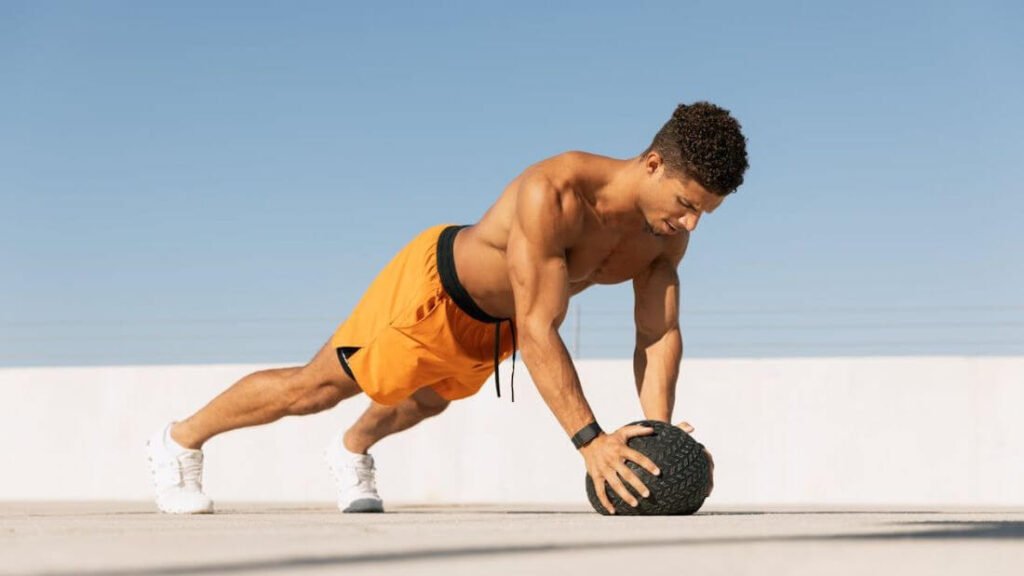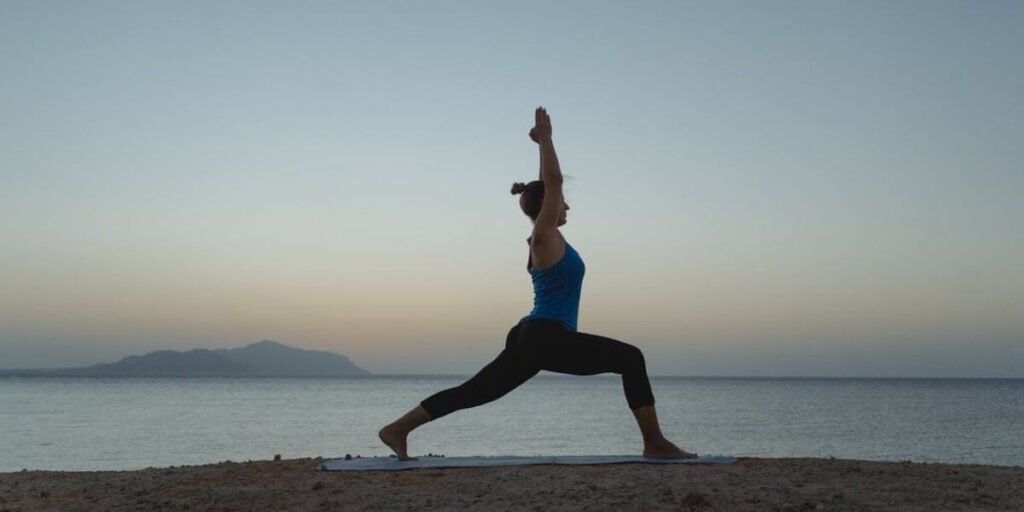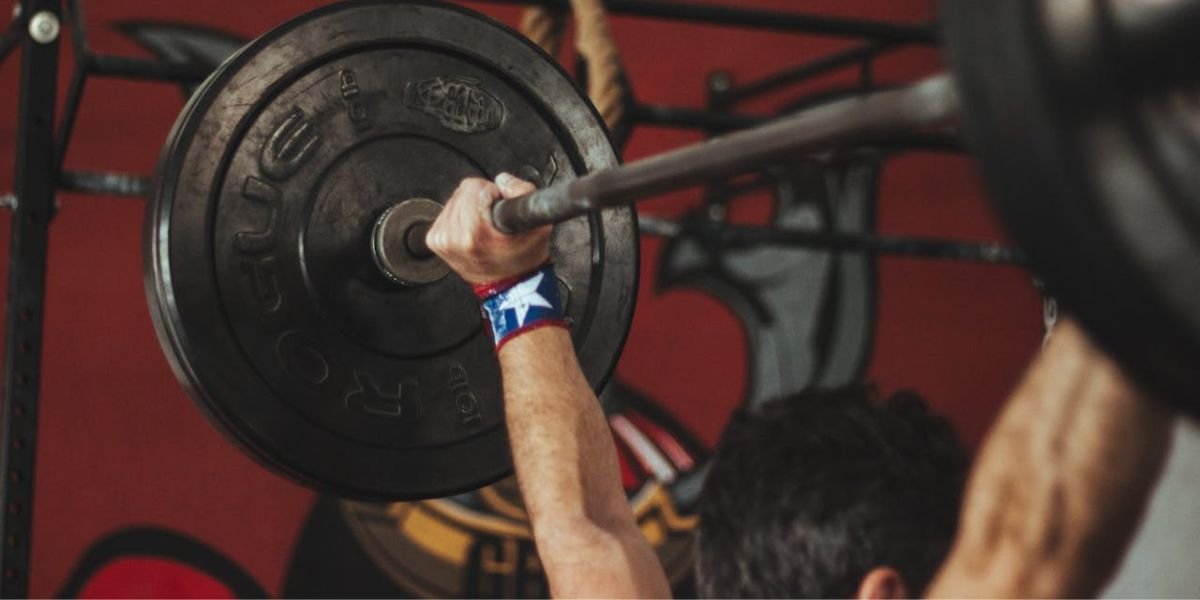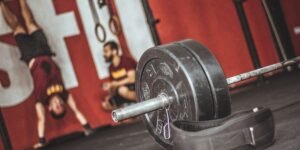Life gets busy. Sometimes the smartest move isn’t chasing progress, but switching on autopilot and holding what you’ve built. The good news? It takes far less than you think to maintain fitness.
This is science-backed research on exactly what you need to maintain Cardiovascular Endurance, Muscular Strength, and mobility and flexibility.
As well as a practical framework, using these Standards to keep your fitness by following the Minimum Effective Standards. All designed to save you time and save your gains.
Want to hold onto your gains? This is a big one, so let’s get to it!
Table of Contents
What Kind of Fitness?

The fitness we cover is from What Is Real Fitness, where we discussed the 10 components of fitness and understanding what it means to be fit.
Using the 10 components, we can break them up into three main pillars, all covered in our How to Train for Lifelong Fitness.
The goal here with maintaining fitness isn’t to peak in one area or neglect another; it’s to stay well-rounded, capable, and overall fit.
You can focus on the pillar you care about most, but for lifelong fitness, all three are equally important.
Here’s a refresher on the three core pillars and how they relate to maintaining your fitness:
- Cardiovascular Endurance
Maintaining means: Holding your level of conditioning.
Through all forms of cardio. This is what keeps you feeling fit, functional, and capable during hikes, runs, or just long days on your feet.
- Muscular Strength
Maintaining means: Keeping your muscle size and strength.
Through all forms of resistance training. This is what keeps you looking and feeling fit and strong.
- Mobility & Flexibility
Maintaining means: Holding onto your mobility and flexibility.
Through any stretches and movement. This is your range of motion, which helps keep you pain-free, moving well, and resistant to injury.
Maintain fitness: The Why and When to Use

No matter what you do, there will be times in life when making gains isn’t an option, and you will need to maintain fitness; otherwise you will regress.
That’s the beauty of maintenance: you don’t have to restart or feel behind when you ramp things back up. These minimums provide an effective stimulus for half the amount of work.
Time is the biggest enemy; the longer the break, the more important these become.
When to start using these:
- Any short break under 2 weeks is normally fine for your gains and might even benefit from the rest and recovery.
- Any long break over 2-4 weeks is where you will lose gains at varying rates if you do nothing.
The Minimum Effective Dose: Cardio, Strength and Mobility
What MED Actually Means:
The Minimum Effective Dose (MED) is the smallest amount of work you need to maintain fitness or even slightly improve if it’s been neglected.
MED helps you make the most of your time, set a clear minimum standard, and avoid losing progress.
TIP:
MED is your fitness insurance policy, keeping you from losing what you’ve built for half the price.
Key Terms (Quick Reference):
Here is a quick list of the terms and abbreviations we use, with the main terms in the table and extras in the dot points below.
| Term: | Meaning: | Example: |
| Frequency | Number of sessions per week | 4 runs |
| Volume | Total work per week (time/distance or sets) | 160 min |
| Intensity | How hard you work | 90–95% HRmax, RPE 8–9 |
- HRmax: Max heart rate. Quick estimate = 220 − age.
- RPE: Rate of Perceived Exertion, 0–10 scale of effort.
- VO₂max: Max oxygen your body can use. Think of it as your “engine size” for endurance.
- Endurance: Ability to sustain effort (1–3 hrs). Driven by fuel efficiency (lactate threshold).
- 1RM: One-rep max. The heaviest weight you can lift.
Cardiovascular Endurance, MED:

What You Need:
To maintain cardiovascular fitness:
- 2 sessions per week.
- 20–30 minutes each.
- Hard effort (intervals, hills, sprints, circuits).
That’s it, refined, simple and sustainable. (Research below)
TIP:
IMPORTANT: Don’t cut intensity.
Why It Works
Research on maintaining cardiovascular fitness is limited (most studies max out at 15 weeks), but it gives us clear insights into how little training you actually need to maintain VO₂max and endurance.
These findings come from the Journal of Strength and Conditioning Research review on Maintaining Physical Performance.
Main takeaway:
- Frequency and volume can drop by 33–66% of your current training, while maintaining VO₂max (as little as 13 minutes per session), as long as intensity stays high.
- Keeping 2 sessions at 20-30 mins per week is a simple and refined breakdown for most people, with some extra padding built into the volume. Remember, you could make this more or a little less by using the percentage above.
VO₂max (aerobic power):
- Intensity is non-negotiable. Keep efforts around 90–95% HRmax (roughly an RPE of 8–9).
- At the very least, intensity must stay above ~82–87% HRmax if frequency and volume are held steady.
- Drop intensity further, and VO₂max tends to decline quickly.
Long-term endurance (sustained efforts of 1–3 hours):
- No firm “minimum frequency” has been found, so it’s safest to keep training frequency close to your usual if this is your goal.
- Volume can drop by about 33% (e.g., a 90-minute long run → 60 minutes) if you keep intensity and frequency up. (as high as your typical training intensity)
- The fitter you are, the more important it is to keep intensity high. Due to your body being more adapted and efficient to the exercise. Less-trained people can sometimes get away with slightly easier efforts because it is still a “hard effort” for your body.
Using Moderate/Light Sessions:
- Replacing hard sessions with moderate (~70–75% HRmax) efforts will likely reduce VO₂max over a few weeks if done exclusively.
- A balanced approach: 1 hard session + 1 moderate session per week might work if total weekly volume is slightly increased and the hard session remains intense as well as a HIIT type of workout.
Example:
- If you normally run 4 x 40 min/week (160 min total), you can cut to 2 x 13–26 min of high-intensity intervals and maintain VO₂max.
- This represents ~75% less training time while holding your fitness level.
TIP:
Two short, hard sessions per week are the safest minimum to maintain cardio fitness.
Practical Options:
- Threshold sessions, holding a hard pace (90–95% max HR) for 20 mins or 4 rounds of 5 mins holding a hard pace with 2min recovery (total 28mins).
- Hill sprints or stair sprints (fast up, walk down for, total 20-30mins, rest if needed).
- HIIT bodyweight circuits (burpees, jump squats, mountain climbers, multiple rounds with short rest).
Personal Experience :
From my own travel and training over the past 5 months, where I have aimed to maintain:
- I’ve been doing 1–2 hard cardio sessions per week (minimum 1 run) plus 1 short HIIT session (5–10 min).
- My weekly volume is often higher than necessary, even if the Intensity is on the lower side (around 80% max HR).
- Despite irregular schedules and limited access to ideal training conditions, my VO₂max has increased by 2 points on my Garmin watch.
I credit my VO₂max increase to doing more high-intensity work than steady state. This also aligns with research showing high-intensity training can improve VO₂max (aerobic capacity) even at lower frequency.
Keep an eye out for how to stay fit while travelling, as we will go over how all this relates and more personal experiences for other factors, such as no routine and limited equipment.
Muscular Strength, MED

What You Need:
To maintain muscle size and strength:
- 1–2 strength sessions per week.
- 1–3 sets per major muscle group per session.
- High intensity effort (~75–85% 1RM, RPE 7–9).
- Focus on major compound movements: squats, deadlifts, presses, rows, pull-ups, push-ups.
TIP:
Your age is a factor too (Research below)
Why It Works
According to the same review on maintaining physical performance, the research shows that strength and muscle mass are highly intensity-dependent.
Main takeaway:
- Frequency: Just 1 strength session per week can fully maintain or even increase 1RM strength for up to 32 weeks (about 7 months), if intensity is maintained.
- Volume: Even reducing to 1 set per exercise per week can preserve both strength and muscle size in younger adults for up to 32 weeks
- Intensity: Lifting at ~75–85% of your 1RM (RPE 7–9) ensures a strong enough stimulus. Train close to failure (slow and hard last reps with clean form).
- Single-set work for maintenance, especially in well-trained or younger adults; multiple sets slightly improve retention for older adults or advanced lifters.
Age Differences:
- Younger adults (∼20–35 years old): 1 session/week, 1 set/exercise.
- Middle-aged adults (∼36–59 years old): 2 sessions/week, 2–3 sets/exercise (approximation).
- Older adults (∼60–75 years old): 2 sessions/week, 2–3 sets/exercise.
Example:
If you normally lift 3 x per week, 3 sets/exercise, maintenance can be as simple as:
- Younger adult: 1 session/week, 1 set/exercise (squats, bench, rows).
- Mid-Older adult: 2 sessions/week, 2–3 sets/exercise.
Time saved: ~50–70% of usual training load, while maintaining strength and muscle size.
Practical Options:
- Barbell lifts / Dumbbells: Squats, Deadlifts, Rows, Bench presses, Overhead presses (Heavy: 1–3 sets at 75–85% 1RM)
- Bodyweight: Push-ups, pull-ups, dips, squats, lunges (Hard: 1–3 sets per muscle group)
- Home-friendly: 15–25 min full-body session targeting all major muscle groups with 2-3 sets per exercise.
Personal Experience:
My aim has also been to maintain muscle size and strength over the past 5 months while travelling. This would be a bit different if I were maintaining at home with access to a gym, but this is what I have done while travelling:
- 1–2 full-body body sessions per week using bodyweight and makeshift weights.
- 3-4 hard sets per exercise (higher than needed, working on muscular endurance).
- Using everything I can: Bodyweight, Callisthenics, HIIT workouts and makeshift weights and CrossFit-inspired workouts.
- Eating high protein is especially important for keeping muscle size, and I have aimed for a minimum of 100g per day.
I have found muscle strength harder than muscle size to keep; maintaining strength would likely be a bit different and more on trend with the current research if I were to use a proper gym and routine with heavy weights.
I’ll go into more detail on how this relates and more practical options, and what I’ve done in the next post, Staying Fit While Travelling Long Term.
Mobility & Flexibility, MED

What You Need:
To maintain mobility and flexibility:
- 1 session per week.
- 5–10 minutes per session.
- Dynamic and static stretching.
- Focus on major joints: hips, shoulders, ankles, and spine.
TIP:
Flexibility can be maintained with minimal weekly stimulus.
Why It Works
Regular stretching exercises can help preserve range of motion, reduce stiffness, and improve overall mobility.
These findings come from a recent Meta-Analysis and review on Optimising the Dose of Static Stretching to Improve Flexibility.
Main takeaway:
- Frequency: Engaging in flexibility stretches 1 time per week is sufficient to maintain joint flexibility and mobility.
- Duration: 4 min total volume, in a single session or 10 min per week from multiple sessions was all that’s needed.
- Target Areas: Emphasise stretches that target the hips, shoulders, spine, and hamstrings or some of your areas more prone to stiffness.
- Type of Stretching: Incorporate both dynamic stretching (e.g., leg swings, arm circles) before activities and static stretching (e.g., hamstring stretch, calf stretch) after activities to improve and maintain flexibility.
Other research also shows that maintaining flexibility and joint mobility is crucial for functional independence, especially in older adults.
Example:
If you typically do any type of flexibility exercises 3 times a week for 30 minutes.
You can maintain your flexibility by reducing the frequency to 1 session per week, lasting 5-10minutes.
Or you can keep it longer if you like, as long as you’re focusing on key muscle groups and joints.
Practical Options:
- Static Stretches: Hamstring stretch, calf stretch, shoulder stretch (5–10 minutes after activity)
- Dynamic Stretches: Leg swings, arm circles, torso twists (5–10 minutes before activity.
- Yoga or Pilates: Incorporate sessions focusing on flexibility and mobility.
Personal Experience:
This is what I have done during my travel past 5 months :
- I’ve been doing 1–2 sessions per week (minimum 1 yoga or stretching session).
- Normally, 15–30 minutes long (much more than needed), I like to take my time, so 4 minutes is a bit rushed for me, but is doable.
- These are normally on days I don’t hit hard sessions, and are part of my recovery where I also stay active with lighter hikes, swims, or these morning yoga sessions.
I’m confident in saying what I have done has been plenty.
I can still comfortably do a full depth squat, touch my toes, move around pain-free and alleviate any pain or stiffness quickly. I’m definitely maintaining where I was and even making progress on stretching specific muscles.
Despite irregular schedules and limited access to ideal training conditions, my flexibility has remained stable and is also an enjoyable aspect of my fitness.
TIP:
Larger improvements are seen with a poor baseline of flexibility.
Recap: Minimum Effective Dose for Maintaining Fitness
You don’t need to do “everything” to stay fit. But you do need to consistently hit the minimum effective dose in these three pillars:
| Pillar | Frequency | Time Needed | Focus |
|---|---|---|---|
| Strength | 1–2x per week | 20–40 min/session | 1–3 sets per major movement, near-max effort. |
| Cardio | 2x per week | 15–30 min/session | High-intensity intervals or intense steady-state movement |
| Mobility | 1x per week | 5–10 min/session | Stretches targeting major joints and muscles. |
Personal Standards & Goals
So, you know the minimum effective dose, the least you need to do to maintain fitness. Now the question is: how do you use them to stay consistent?
That’s where setting personal standards comes in.
Standards are simple, non-negotiable rules you live by that anchor your day-to-day actions
Standards are a must and often set around your goals or what you want to achieve, but are more concrete than those goals.
TIP:
Standards are like your laws of fitness; you don’t want to break them.
Putting It All Together: Minimum Effective Standards (MES)

When you combine both the MED and setting your own personal standards, you get Minimum Effective Standards (MES), the practical framework to stay consistent and on track with your fitness over time:
- MED = the science (what you need to do to stay fit)
- Standards = your non-negotiables (how you will apply it)
- Goals = your direction (what you’re working toward)
MES Examples:
Cardio Example (VO₂max focus):
- Minimum Effective Dose (MED): 2x per week, 20–30 mins, hard runs or interval.
- Standard: Always make time for 2 runs weekly, even if they aren’t fast, get them done whenever physically possible.
- Goal: Maintain VO₂max for 12 months (While travelling).
Strength Example:
- MED: 1 set per muscle group, near-failure, 2× per week.
- Standard: Hit at least 2 full-body sessions weekly, even if it’s just bodyweight.
- Goal: Regain or improve 1RM strength once back in a proper gym.
Mobility Example:
- MED: 5-10 min of focused work, 1x per week.
- Standard: Move joints through full range, minimum once a week, even if it’s just a quick stretch before bed.
- Goal: Maintain mobility and pain-free training with a full range of motion.
Summary:
At the end of the day, fitness isn’t always about chasing gains; it’s about building something that improves your life and actually lasts.
The 3 Pillars: strength, cardio, and mobility, are your foundation. Hit the minimum effective dose, set your personal standards, and aim for goals that excite you.
That’s the framework for staying fit, whether you’re stuck at home, in a busy season at work, or living out of a backpack on the road.
Maintenance isn’t failure. It’s a crucial phase everyone hits, even the most committed and if you’re looking to ramp things back up, you can find how to Build Your Own Plan and Train for Lifelong Fitness.
This is what Pioneer Gains is all about: keeping it practical and showing you how to make fitness part of your life for the long run.
Want more? Follow Pioneer Gains on Instagram or Facebook, and check back here for the next post on how to keep your fitness alive while travelling long-term.
Have any questions or suggestions? Feel free to contact us here.
References:
- Spiering, B. A., Mujika, I., Sharp, M. A., & Foulis, S. A. (2021). Maintaining Physical Performance: The Minimal Dose of Exercise Needed to Preserve Endurance and Strength Over Time. Journal of Strength and Conditioning Research, 35(5), 1449–1458. Available at: https://journals.lww.com/nsca-jscr/fulltext/2021/05000/Maintaining_Physical_Performance__The_Minimal_Dose.35.aspx/1000
- Milanović, Z., Sporiš, G., & Weston, M. (2015). Effectiveness of High-Intensity Interval Training (HIT) and Continuous Endurance Training for VO₂max Improvements: A Systematic Review and Meta-Analysis of Controlled Trials. Sports Medicine, 45, 1469–1481. Available at: https://link.springer.com/article/10.1007/s40279-015-0365-0
- Thomas, E., Bianco, A., Paoli, A., & Palma, A. (2024). Effects of Stretching on Performance: A Systematic Review. Sports Medicine. Available at: https://pubmed.ncbi.nlm.nih.gov/39614059/
- Ogasawara, R., Yasuda, T., Ishii, N., & Abe, T. (2011). Comparison of Muscle Hypertrophy Following 6-Month Continuous and Periodic Strength Training. European Journal of Applied Physiology. Available at: https://www.sciencedirect.com/science/article/abs/pii/S0001457512003442




